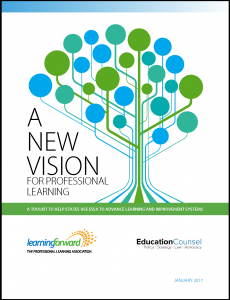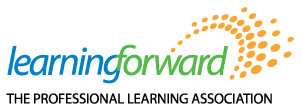
Learning Forward Advocacy
Events are unfolding rapidly. Stay tuned to this advocacy page for the latest information.
Late on Friday, May 30th, the White House followed up on its release of the so-called FY26 “skinny budget” with a more fully fleshed-out version. This new document retains the overall goal of slashing the Department of Education’s budget by 15.3% by proposing to eliminate $12 billion from existing programs. A large chunk of these cuts would come from K-12 programs, including the elimination of the $890 million Title III English Language Acquisition program and the consolidation of 18 programs, totaling approximately $6.5 billion into a $2 billion block grant. The only increase in K-12 would be to the Charter Schools program – a plus up of $60 million, which is in keeping with the Administration’s goal of expanding school choice. Several key higher education programs are also slated for full elimination, including the $1.2 billion TRIO programs, the $910 million Supplemental Equal Opportunity Grants, and the $388 million GEAR-UP program, and maximum Pell Grant awards would see a 22% reduction.
The full budget also contains significant changes for the largest K-12 education programs – Title I and IDEA. While it would level fund Title I-A, the main state grant program, it would eliminate or consolidate into the new block grant the other Title I programs. For IDEA, the budget would level fund all special education programs but collapse all of them into a single formula grant. Other major programs, such as Perkins Career and Technical Education and Impact Aid would be level funded and unchanged structurally.
The K-12 block grant proposal, the centerpiece of this budget, merits a little deeper exploration. It is sweeping in scope, including large programs like Title II-A and Title IV-A as well as many smaller, niche programs like Native Hawaiian Education and Alaska Native Education. The budget book, under the headline “Cutting the Federal Red Tape,” explains the rationale for the proposed consolidation: “For decades, federal support for education has been doled out as part of numerous small, poorly designed programs that create silos and are ill-suited to state-specific contexts. As a result, states are forced to hire increasingly large numbers of staff not to serve students, but to apply for competitive grants and manage the bureaucratic red tape imposed by the federal government. At the same time, appropriations for these siloed, unnecessarily complex, and largely unproven programs have grown, increasing the federal footprint without commensurate improvements in students’ academic achievement.”
While the stated premise of the block grant is to provide states and localities flexibility to use the funds in “a manner consistent with the needs of their communities,” the block grant would require a 7.5% minimum reservation of funds for reading instruction, one of Secretary McMahon’s three Departmental priorities.
Here is the full list of programs that would be consolidated and their FY24 appropriation levels:
- Comprehensive literacy development grants (Title I) – $194 million
- Innovative approaches to literacy (Title I) – $30 million
- State agency: neglected and delinquent children (Title I) – $49 million
- Supporting effective instruction state grants (Title II-A) – $2.19 billion
- 21st century community learning centers – $1.33 billion
- State assessments – $380 million
- Education for homeless children and youths – $129 million
- Native Hawaiian education – $46 million
- Alaska Native education – $45 million
- Rural education – $220 million
- Student support and academic enrichment – $1.38 million
- School safety national activities – $216 million
- Promise Neighborhoods – $91 million
- American history and civics academies – $23 million
- Magnet school assistance – $139 million
- Arts in education – $37 million
- Javits gifted and talented – $17 million
- Statewide family engagement centers – $20 million
While the Department of Education’s budget book leads with a quote from President Trump from his Executive Order to close the Department, the budget contains no request to move key parts of the Department to other federal agencies. There is no mention of moving IDEA to HHS, shipping the student loan portfolio to the Department of Treasury or to the Small Business Administration, or moving the Office of Civil Rights to the Department of Justice. According to the budget, the Institute of Educational Sciences (IES), which the Administration effectively eliminated through staff firings and contract and grant terminations, is not completely dead yet. While providing it no funds, the budget book states: “The Administration is currently in the midst of reimagining a more efficient, effective, and useful IES to improve support for evidence-based accountability, data-driven decision making, and education research for use in the classroom.”
With this full budget’s release, the ball is now in Congress’ court to fashion final FY26 appropriations bills that take into account the President’s priorities. While challenging in any year, this proposed budget is perhaps more nettlesome than many others that any administration has produced. For one thing, it proposes massive structural changes to a number of programs – a K-12 block grant and the collapsing of all Title I and IDEA programs into formula grants – that would require statutory changes. For another, it defunds bipartisanly supported programs, such as rural education, TRIO and GEAR-UP. Finally, with concerns still remaining over the final FY25 allocations for important K-12 programs, including Title II-A, Congress is still struggling to understand the baseline figures from which it will work.
Below is a breakdown of key K-12 program funding levels:

* Assumes FY24 allocation level.
A-Team federal update, February, 2025
White House rescinds Jan. 27 memo pausing disbursement of federal grants, loans
Join the Learning Forward A-Team in 2025 for regular policy updates
The Learning Forward Advocacy Team is your trusted source for news and updates on federal education policy, particularly the latest news on Title II-A. Signing up for the A-Team will ensure that you receive:
- Access to the latest education policy news through email updates
- An invitation to join a monthly 30-minute Zoom call for a federal update with opportunity to get your specific questions answered (2nd Tuesday of every month at 5 p.m. ET)
- Counsel on local and state policy needs from Learning Forward’s policy team
Sign up today using this link. No advocacy experience required – just information. Stay informed. Join the A-Team today.
Learning Forward Advocacy
Powered by Title II
Communities & members
Resources
Video: How is professional learning important for students?
Call to action: Save Title II-A
Now is not the time to be complacent. We need to remain vigilant in our efforts to save Title II-A. If you are reading this message, please take a moment to send a message to your members of Congress.

Learning Forward’s Powered by Title II campaign website puts all of the information, tools, and advocacy tutorials in one easy to access online location to enable educator advocates reach their Members of Congress and help convince them to support more Title II funding. On this site, advocates will find:
- The latest news on Title II
- Background facts, stories, research, and data on Title II
- A storytelling tool to assist you in researching and explaining how Title II supports your school district
- Sample letters, talking points, tweets and more to support your advocacy
Evidence, evidence, evidence
Evidence of impact is not optional. From your ESSA plans to Title II to talking with your district superintendent, everyone wants to know when professional development is making an impact and how you know. Learning Forward is here to help. We invite you to join your peers from across the U.S. to share your successes here.
Tell us what Title II funds in your school or district, and most important, what outcomes you see as a result. Outcomes might include improved graduation rates or assessment scores, improvements for specific populations of students, or other indicators that students are experiencing more meaningful learning.
This webinar, originally created for our Virtual Advocacy Day, includes advocacy strategies and tips that are applicable to any advocacy effort. Watch to hone your skills, build confidence, and get excited about being an advocate.
ESSA Toolkits
 A New Vision For Professional Learning: A Toolkit to Help
A New Vision For Professional Learning: A Toolkit to Help
States Use ESSA to Advance Learning and ImprovementSystems. This toolkit helps leaders leverage professional learning as
an essential tool in overcoming systemic inequities and guaranteeing
excellence for all.
Agents for Learning Toolkit: A Guide to Amplifying Teacher
Voice and Stakeholder Engagement. This toolkit suggests ways to cultivate teacher voice and agency in policy decisions and the implementation of professional learning.


